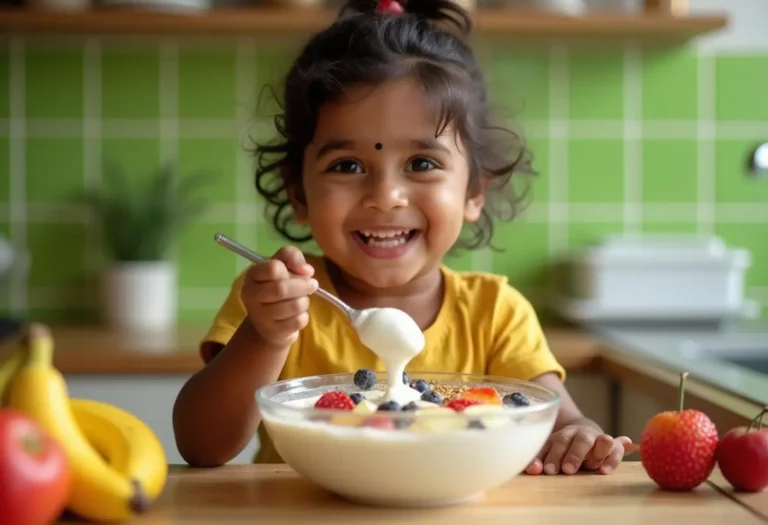Understanding the causes and remedies for tooth decay in young children is a crucial part of safeguarding your child’s overall health and well-being. It’s the middle of the night in Pune, a time when a small discovery—like a tiny chalky spot or a dark line on your sleeping child’s tooth—can spark a wave of anxiety. A thousand questions might race through your mind: “How did this happen? Is it my fault? Are they in pain?”
If you are feeling this worry, please know you are not alone. Tooth decay in young children is one of the most common chronic childhood conditions, but it is also highly preventable.1 This guide is here to replace your anxiety with knowledge and a clear, actionable plan.
Let’s walk through the fundamentals of why tooth decay happens and, most importantly, the preventative steps and supportive care you can provide.
A Crucial First Note: This guide focuses on understanding and prevention. If you already see signs of a cavity, the single most important “remedy” is to schedule an appointment with a pediatric dentist.2 They are the only ones who can treat existing decay.
Table of Contents
The Myth of “Just Baby Teeth”: Why Early Dental Health Matters
It’s a common misconception that cavities in baby teeth (primary teeth) don’t matter because they will eventually fall out. This could not be further from the truth. Baby teeth are critically important for:
- Holding Space: They act as placeholders for the permanent teeth to erupt correctly.3 Losing a baby tooth too early can lead to future crowding and orthodontic issues.
- Proper Nutrition and Speech: Healthy teeth are essential for chewing a variety of foods and for clear speech development.
- Preventing Infection: An untreated cavity is a bacterial infection that can be painful and can even spread, affecting the developing permanent tooth below it.
The Primary Causes of Tooth Decay in Young Children
Tooth decay isn’t a random event; it’s a process. In simple terms, it happens when bacteria in the mouth feed on sugars from food, creating acids that eat away at the tooth’s hard outer layer (the enamel).4 Here are the most common culprits:
- Frequent Sugar Exposure: This is the number one cause.5 It includes obvious sources like sweets, chocolates, and sugary drinks, but also hidden sugars in biscuits, ketchup, packaged fruit juices, and breakfast cereals. It’s not just the amount of sugar, but the frequency of exposure that matters.
- Improper Brushing Habits: Not brushing twice a day, not brushing for the full two minutes, or not using the correct technique allows plaque (a sticky film of bacteria) to build up.6
- “Baby Bottle” Tooth Decay: This common issue occurs when a baby or toddler is frequently put to bed with a bottle of milk, formula, or juice.7 The sugars in the liquid pool around the teeth for hours, providing a feast for acid-producing bacteria.
- Bacteria Transmission: The bacteria that cause cavities can be passed from parent to child. This can happen through sharing spoons, cups, or “cleaning” a dropped pacifier with your own mouth.
- Lack of Fluoride: Fluoride is a natural mineral that strengthens tooth enamel and makes it more resistant to acid attacks.8 Not using an age-appropriate fluoride toothpaste can leave teeth vulnerable.9
Prevention and Support: Your Guide to Remedies for Tooth Decay in Young Children
While a dentist is the only one who can fix a cavity, your role as a parent is centered on prevention. Here are the most effective strategies and preventative remedies for tooth decay in young children.
The Number One Remedy: A Visit to the Pediatric Dentist
Let’s say it again: for existing decay, there is no home remedy. A pediatric dentist can provide professional treatments like fillings, fluoride applications, or crowns to stop the decay and save the tooth.10 Regular check-ups (starting from their first birthday) are the best way to catch problems early.11
Preventative “Remedies” You Can Start at Home Today:
- Master the Brushing Routine:
- Brush your child’s teeth twice a day (after breakfast and before bed) for two full minutes.12
- Use an age-appropriate, soft-bristled toothbrush.13
- Use a fluoride toothpaste.14 For children under 3, use a smear the size of a grain of rice.15 For children 3 and over, use a pea-sized amount.16
- Supervise brushing until they are at least 7 or 8 years old to ensure they are doing it effectively.17
- Smart Snacking and Dietary Changes:
- Limit sugary and sticky snacks.18 Offer “tooth-friendly” alternatives like cheese, paneer cubes, plain yogurt (dahi), apple slices, and crunchy carrots.
- After any meal or snack, encourage your child to drink or swish with water to rinse away food particles.19
- Make Water the Main Drink:
- Get your child in the habit of drinking plain water for thirst. Keep juices and other sugary drinks as occasional treats, not daily staples.20
- End the Night Bottle:
- Work on weaning your child off a bedtime bottle by their first birthday. If they have a bottle, it should only contain water after their teeth have been brushed for the night.21
- Consider Dental Sealants:
- This is a fantastic preventative measure a dentist can provide. A sealant is a thin, protective coating applied to the chewing surfaces of the back teeth (molars) to prevent cavities from forming in the pits and fissures.22
A Note on Traditional Indian Habits
Our culture is rich with delicious foods, including many sweets (mithai). While these are a joyful part of celebrations, it’s wise to:
- Limit them to special occasions rather than making them a daily treat.23
- Encourage your child to rinse their mouth with water immediately after eating them.
- Be mindful of the sugar content in drinks like chai or sweetened milk.24
Conclusion: Building a Foundation for a Lifetime of Healthy Smiles
Discovering tooth decay in your child can be upsetting, but it’s an opportunity to build a strong foundation of oral health that will last them a lifetime. Let go of any guilt and focus on these positive, proactive steps.
You are your child’s first and most important teacher. By establishing a consistent brushing routine, making smart food choices, and fostering a positive relationship with the dentist, you are giving them a priceless gift. It’s never too late to start.
What is your biggest challenge when it comes to your child’s dental routine? Let’s share tips and support each other in the comments below.




